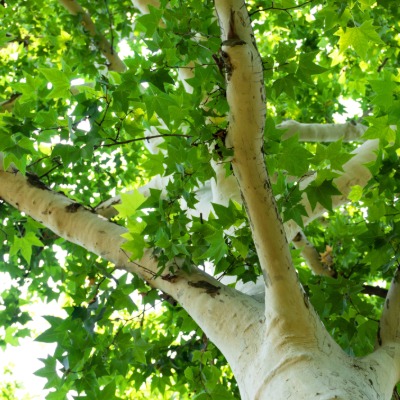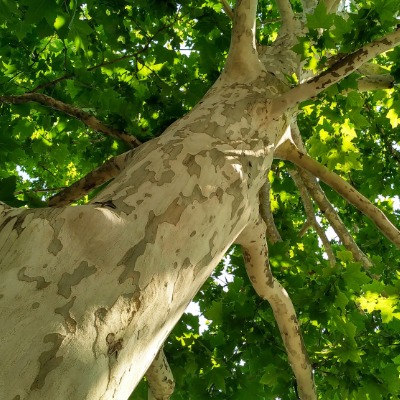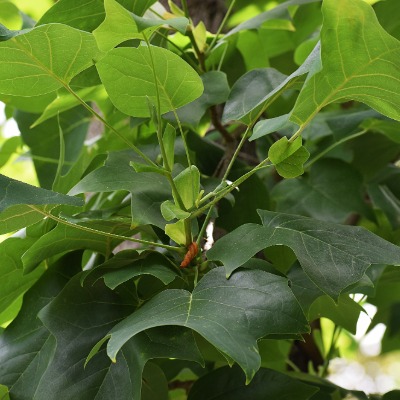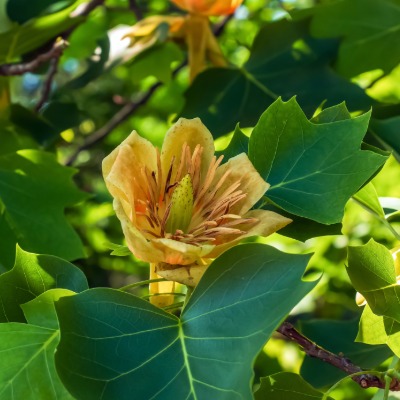LARGE TREES TO PLANT
COMMERCIAL LANDSCAPE MANAGEMENT - SERVICING MARYLAND, DC, AND VIRGINIA
PLANTING LARGE TREES
These are trees that grow up to and over 100 feet, where their majestic stature provides vertical interest, creating a striking visual focal point that draws the eye upward and adds depth to the environment. Their impressive height helps with the naturalization of a space, making tall structures more integrated with the surrounding ecosystem. These large trees serve as effective woodland borders, providing privacy and a natural barrier that delineates property lines. Large trees play a significant role in carbon sequestration due to their substantial biomass, which allows them to absorb and store significant amounts of carbon dioxide from the atmosphere, mitigating the effects of climate change.

The Bitternut Hickory has a distinctive leaf shape characterized by its elongated and pointed leaflets, giving the foliage a unique, feathery appearance. The bark is a light gray to brown hue with a tight interlacing pattern that becomes more pronounced with age. As the seasons change, the leaves exhibit a vibrant transformation, displaying bright yellow hues in the fall. The flowers typically appear in spring, consisting of yellow-green catkins that hang down from the tree. While the nuts are not edible to humans, they are an essential food source for various wildlife species, including squirrels and birds. Renowned for its impressive wood strength and towering height, it can withstand strong winds and extreme weather conditions, making it a perfect choice as a shade tree in wide open spaces.
TYPE
deciduous
HEIGHT
50 - 80 feet
SUN
full sun
SOIL
moist / wet
PURPOSE
ornamental and ecological

The black oak leaves have a lobed structure that transforms into a display of rich hues, ranging from deep greens in the summer to brilliant oranges and reds in the fall. This oak is known for the dark coloration of its bark and rough texture, with branches forming a wide spread canopy. It can attain significant height, with a sturdy trunk that gives a sense of permanence and strength. The crown exhibits a rounded or broad shape, creating a dense canopy that offers shade and shelter. This tree serves as a focal point in wide open spaces, with its robust trunk and distinctive crown shape providing a striking silhouette against the skyline.
TYPE
deciduous
HEIGHT
50 - 80 feet
SUN
full sun / part sun
SOIL
moist / dry
PURPOSE
ornamental and ecological

The Black Sour Gum features a distinctive pyramidal shape; its glossy green leaves transition to vibrant shades of orange and red in the fall. The bark features fissures and blocks that create a textured appearance. The trunk is sturdy and upright, and its branching pattern tends to be irregular, creating a varied canopy. It produces small, dark blue fruit that attracts birds and other wildlife and is used in many culinary dishes. The bark often displays a rough texture with deep fissures, giving it a rugged appearance. The crown forms a wide and rounded canopy that provides ample shade. It is an excellent choice for creating natural borders and defining woodland edges in commercial and residential spaces.
TYPE
deciduous
HEIGHT
30 - 75 feet
SUN
full sun / part sun / shade
SOIL
moist / dry / wet
PURPOSE
ornamental and ecological

The chestnut oak leaves are broad and rounded with a glossy appearance, resembling those of the chestnut tree. The expansive canopy is wide and spreading, providing ample shade. The bark is dark gray to brown and has a rugged texture, offering visual interest and a sense of permanence. Its acorns emerge in the fall, offering a food source for various wildlife. Known for its impressive seasonal colors, its vibrant green leaves unfurl in spring, signaling the arrival of warmer weather. As summer progresses, the leaves mature into a rich, dark green, and when autumn arrives, they turn into shades of yellow, orange, and russet. Its dense shade helps reduce soil erosion and moderates temperatures in urban areas.
TYPE
deciduous
HEIGHT
50 - 70 feet
SUN
shade
SOIL
moist / dry
PURPOSE
ornamental and ecological

The Mockernut Hickory has compound, serrated leaves with leaflets arranged in a staggered pattern on its branches. Its rough, grayish-brown bark becomes furrowed as the tree matures. The branching pattern tends to be irregular, with limbs extending outward and upward, creating a broad canopy. As autumn arrives, the foliage transforms into a vibrant display, with hues ranging from yellow to gold. Its small, yellowish-green flowers bloom during the spring, which later develop into round, hard-shelled nuts. It can effectively reduce wind speed as a windbreaker and in screening to define property lines within a landscape.
TYPE
deciduous
HEIGHT
60 - 80 feet
SUN
full sun / part sun
SOIL
moist / dry
PURPOSE
ornamental and ecological

The Northern Red Oak is known for its broad, lobed leaves with deep sinuses and bristled tips. Its outward-growing branches form an impressive, columnar to a wide-spreading crown. The bark is dark gray to black, with a rugged texture that develops deep fissures as it matures. The tree is recognized for its robust stature and impressive height. It produces small greenish-yellow flowers that emerge in the spring, with acorns maturing in the fall. In spring, its leaves emerge in a vibrant green, transitioning to a rich dark green during summer, and transform into brilliant shades of red and orange in the autumn. Commonly used as a prominent feature in parks and expansive outdoor areas.
TYPE
deciduous
HEIGHT
50 - 90 feet
SUN
shade
SOIL
moist / dry
PURPOSE
ornamental and ecological

The Pignut Hickory leaves are compound, consisting of leaflets that are elongated and pointed. Its rugged bark has a grayish-brown hue with a tight, interlaced pattern. The branching structure is often ascending, creating a well-formed oval crown. It produces small, inconspicuous flowers in the spring, followed by the edible nuts that mature in the fall. The nuts are encased in a hard shell and are known for their rich flavor, making them a food source for various wildlife. In the fall, the foliage transforms into striking shades of yellow and gold and bares its branches during winter to reveal its structural form. The well-defined canopy provides shade, and the seasonal colors make it ideal for ornamental planting.
TYPE
deciduous
HEIGHT
50 - 80 feet
SUN
full sun / part sun
SOIL
moist
PURPOSE
ornamental and ecological

The Pin Oak has pointy lobed leaves with deep sinuses. It has a rough, dark brown bark, which develops deep furrows as it matures. Its branching structure is notable for its layering, with lower branches often hanging down and upper branches extending outward, creating a pyramidal canopy. The tree produces small, round acorns that serve as a food source for various wildlife species. The foliage remains a rich green in the summer and transitions to shades of red and bronze tones in the fall, creating a striking visual display as they gradually shed for winter. Known as the fastest-growing oak, they are cultivated for their strong root system to help prevent erosion and maintain soil integrity.
TYPE
deciduous
HEIGHT
50 - 80 feet
SUN
full sun
SOIL
moist / wet
PURPOSE
ornamental and ecological

Pitch Pine has long, slender, dark green three-needle fascicles and resinous buds. Known for its tall, straight trunk, it reaches great heights and has a broad, pyramidal crown. Its bark is dark brown, often developing deep grooves as it matures. The cones remain closed, protecting the seeds inside until conditions are favorable for germination. When exposed to heat, the cones open to release the seeds. In warmer months, the foliage exhibits a rich green hue, while in the fall, it may shift to shades of yellow and brown until the winter season. The tree's ability to withstand fire and poor soil conditions makes it an excellent choice for reforestation efforts and erosion control.
TYPE
evergreen
HEIGHT
40 - 70 feet
SUN
full sun
SOIL
dry
PURPOSE
ornamental and ecological

The Red Maple has lobed, outlined leaves and comes in a shade of red all year long, along with twigs and seeds, and flowers. It has a smooth, grayish bark that matures to a darker, furrowed texture. Its trunk can grow to a considerable height, often with a canopy that spreads wide. The branching structure of the tree is typically open and rounded, allowing sunlight to filter through in between the red foliage. This tree produces small, clustered flowers that typically bloom in early spring, signaling the arrival of warmer weather. Following the flowering stage, it develops winged fruits, called samaras, which are dispersed by the wind. Ideal for planting in courtyards and open spaces, and away from structures and pathways due to its shallow root system.
TYPE
deciduous
HEIGHT
40 - 70 feet
SUN
full sun / part sun / shade
SOIL
dry / moist / wet
PURPOSE
ornamental and ecological

The River Birch leaves are oval to triangular in shape serrated margins with a vibrant green color that turns bright yellow in the fall. It features a multi-stemmed trunk that exhibits a peeling, exfoliating bark in shades of cinnamon and brown. The tree's branching structure tends to grow upward to form a pyramidal to a broad, rounded canopy. It produces small catkins in the spring, around the same time the leaves emerge in a fresh light green hue that gradually deepens into a richer green in summer and transforms into shades of yellow and orange in the fall. Its ability to thrive in wet conditions makes it an ideal choice for rain gardens and near water features, where it can help manage excess water runoff. It has a relatively fast growth rate, making it a practical option for those looking to establish greenery quickly.
TYPE
deciduous
HEIGHT
50 - 70 feet
SUN
full sun / part sun
SOIL
moist / wet
PURPOSE
ornamental and ecological

The Scarlet Oak has pointed lobed leaves that transition to a striking scarlet red color in the fall. The bark is dark gray to brown, with a rough texture and deep ridges and furrows that become more pronounced as the tree matures. Its branches extend outward, creating a wide, rounded crown. The tree produces small, cup-shaped acorns that are less than half an inch in size. Known for its striking seasonal colors, particularly during the fall when its leaves transform into fiery shades of red. This oak is known for its strong wood and resistance to various pests and diseases, which supports its longevity and low maintenance requirements. It is often used for its impressive height and broad spread, making it effective for creating windbreaks and providing shade as street plantings.
TYPE
deciduous
HEIGHT
50 - 80 feet
SUN
full sun
SOIL
moist / dry
PURPOSE
ornamental and ecological

The Shagbark Hickory has compound leaves of elongated leaflets with a serrated margin, with a rich yellow color. This Prince William native is renowned for its longevity and shaggy, peeling bark that reveals a smooth surface underneath. The long, sweeping branches arch outward and upward, creating a rounded canopy. The shaggy strips that curl away from the trunk not only add to its visual interest but also help to protect the tree from pests and diseases. It produces small, greenish-yellow flowers in the spring, followed by hard, round nuts in a husk. It is notable for its vibrant, even luminous, yellow to golden hues in the fall. This slow-growing tree has a deep root system that aids in soil stabilization and reduces erosion.
TYPE
deciduous
HEIGHT
50 - 80 feet
SUN
full sun / part sun
SOIL
moist / dry / wet
PURPOSE
ornamental and ecological

The Shortleaf Pine has slender and flexible needle-like leaves arranged in bundles of two or three. The bark is grayish-brown and scaly, providing a robust outer layer that protects the tree from environmental stressors. It reaches significant heights with a dense conical canopy of needle-like leaves arranged in a whorled pattern, which allows for effective light capture and filtering for understory plantings. The tree stands out with its evergreen needles, maintaining structure and form in any season. It produces small, yellowish flowers that appear in spring, with male cones releasing pollen and female cones developing over time into new trees. It is very effective in carbon sequestration as it greatly reduces atmospheric carbon dioxide levels and may be planted in urban areas as shade trees, windbreaks, or visual screens.
TYPE
evergreen
HEIGHT
50 - 100 feet
SUN
full sun
SOIL
moist / dry
PURPOSE
ornamental and ecological

The Southern Red Oak leaves are lobed with deep sinuses that create pointed tips and a vibrant russet fall color. The rugged bark is dark gray to brown, with a scaly texture that becomes more pronounced as the tree matures. The tree's limbs grow at a wide angle to form a dense, spreading canopy. The tree produces small acorns that mature in the autumn, providing a food source for various wildlife. The leaves emerge bright green in the spring and deepen in the summer, before transforming into a deep red or russet brown color in the fall. Its dense foliage contributes to air quality improvement and provides shade that helps moderate urban heat. Its impressive height and broad canopy can create a natural focal point in parks and yards, while also serving as a windbreak or noise barrier.
TYPE
deciduous
HEIGHT
60 - 80 feet
SUN
full sun
SOIL
moist / dry
PURPOSE
ornamental and ecological

The Swamp Chestnut Oak features leaves that are broad, lobed, and serrated with a rich yellow-brown fall color. The bark is light gray, rugged, and furrowed as it matures. It has a broad, spreading crown and expansive branching structure. It produces acorns in the fall that are larger than most other oaks. Its leaves are dark green, turning to shades of yellow and brown in the fall. It thrives in wetland areas, particularly along the edges of swamps and streams. Its adaptability to moist soil conditions and its capability to withstand periodic flooding make it a suitable choice for streetscapes, ponds, and streams. Its deep root system aids in soil stabilization and reduces erosion, making it an excellent choice for areas prone to flooding or water runoff.
TYPE
deciduous
HEIGHT
60 - 80 feet
SUN
full sun
SOIL
moist / wet
PURPOSE
ornamental and ecological

The Swamp White Oak has broad, lobed bicolor leaves with a rich green color on the surface and a lighter silvery hue on the underside, with yellow and orange fall colors. Its light gray bark becomes deeply furrowed with age. Its branching pattern has an irregular and upward structure, forming a spreading canopy. It produces small catkins in spring, followed by acorns that are a vital food source for wildlife. The tree's leaves are dark green in the summer, transitioning to a vibrant mix of yellow, orange, and brown in the fall. Commonly found near swamps and lakes, the tree contributes to soil stabilization, preventing erosion with its extensive root system.
TYPE
deciduous
HEIGHT
50 - 70 feet
SUN
full sun / part sun / shade
SOIL
moist / wet / dry
PURPOSE
ornamental and ecological

Sweetgum trees feature star-shaped, lobed leaves with yellow, orange, and red fall colors. The bark is rough and deeply furrowed, with a grayish-brown color that becomes darker as the tree matures. The branches grow upward, creating a symmetric conical and semi-rounded crown. The flowers that bloom in spring are small and yellow-green and eventually give way to the tree's iconic spiky gumball-like fruit that matures in the fall. The leaves maintain their dark green color until they take on a dramatic shift to a range of colors from yellow, orange, red, and purple in the fall. The fallen spiky fruit can be a maintenance challenge, but certain cultivars don't produce them. Known for their ability to thrive in a variety of soil types and live for hundreds of years, it is an excellent choice for reforestation and naturalization efforts.
TYPE
deciduous
HEIGHT
60 - 75 feet
SUN
full sun / part sun
SOIL
moist / wet
PURPOSE
ornamental and ecological

The Sycamore tree has large, broad leaves that are palmate with a rough texture and glossy appearance. The bark exhibits a mottled pattern, characterized by its peeling and exfoliating nature, which reveals a lighter inner layer. It has an expansive branching structure forming a broad oval canopy. They produce small, winged fruits, called samaras, which are dispersed by the wind. The flowers, called panicles, appear in the spring before the leaves fully unfold. The leaves turn a deeper green in the summer before transitioning into bright yellow in the fall. They are resilient and pest-resistant due to their mottled bark and can handle urban stressors such as pollution and compacted soils, making them suitable for creating natural barriers or windbreaks.
TYPE
deciduous
HEIGHT
75 - 100 feet
SUN
full sun / part sun
SOIL
dry / moist / wet
PURPOSE
ornamental and ecological

The Tulip Tree has large, squarish, lobed, and pointed leaves that turn yellow in the fall. The gray bark is smooth and becomes furrowed and ridged as it matures. It is renowned for its tall stature and impressive size, and a broad, pyramidal canopy. It produces large, tulip-shaped flowers that bloom in late spring, featuring a yellow-green color with an orange band, followed by cone-like fruit. During autumn, the leaves transition to vibrant shades of yellow and gold. They are notable for their midwood characteristics, acting as carbon sinks, which help mitigate climate change by absorbing a significant amount of carbon dioxide into their large biomass. They are best planted in yards and parks, but they are viable urban street plantings as long as their root system is given ample space between structures.
TYPE
deciduous
HEIGHT
75 - 100 feet
SUN
full sun / part sun
SOIL
dry / moist / wet
PURPOSE
ornamental and ecological

The White Oak leaves are lobed with rounded tips and a leathery texture, with red, orange, or brown fall colors. The rugged bark is grayish to light brown in color and is deeply furrowed. Its alternating branching structure forms an irregularly broad and rounded crown. The tree produces small flowers that appear in spring, with male flowers forming in long catkins and female flowers being solitary and bearing acorns. In the fall, the leaves transition to striking hues of red, orange, and brown, creating a visually dynamic display before they drop in winter. This tree plays a crucial role in supporting wildlife, as its acorns are a primary food source for small mammals and provide habitat for numerous insects, and serve as a host to many species of birds. Its strong and majestic structure and broad canopy make it suitable for long-term planning in both public and private spaces.
TYPE
deciduous
HEIGHT
80 - 100 feet
SUN
full sun / part sun
SOIL
dry / moist
PURPOSE
ornamental and ecological

The Willow Oak features narrow, lance-shaped leaves that resemble willow trees with a glossy green color that turns to a yellow-brown shade in the fall. The bark is dark gray and becomes furrowed with age, providing a rugged texture. The trunk can reach a significant diameter that supports a broad canopy. The branching structure is open and spread out, with leaves alternately positioned, allowing for ample light filtering. It produces small flowers in the spring that are wind-pollinated and followed by acorns in the late summer and fall. During spring and summer, the lush, green foliage gradually turns to yellow or brown. It is renowned for its impressive longevity and resilience, tolerates occasional flooding, and is an effective specimen tree in phytoremediation, a process that involves using plants to remove or neutralize contaminants in the soil and water.
TYPE
deciduous
HEIGHT
60 - 80 feet
SUN
full sun / part sun
SOIL
wet / moist
PURPOSE
ornamental and ecological
Ready to discuss your vision?
Let's schedule a consultation!

















































































































































































































